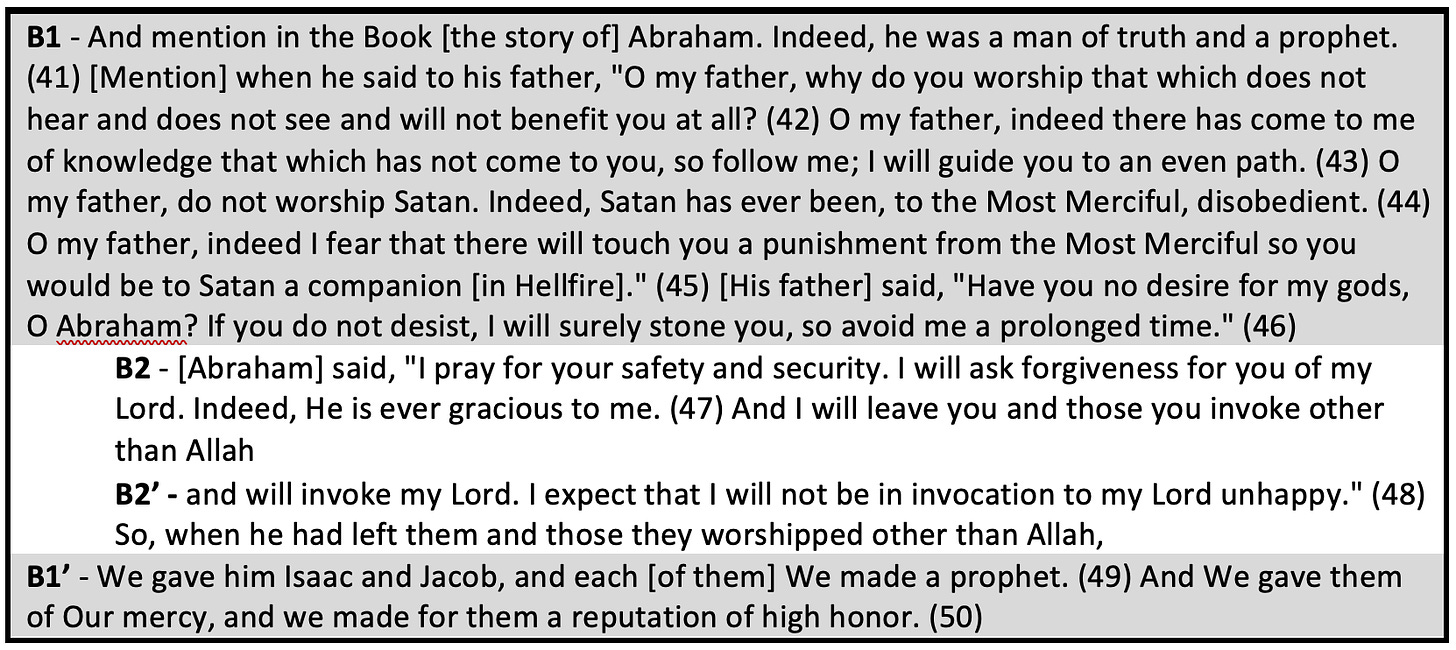Sūrat Maryam (Part 4)
Part 4 of observations on the structure, organization, and coherence of Sūrat Maryam
See last week’s post for Part 3.
Integrative Coherence of Section [A]
Besides the numerous parallels between the stories of Zakariyyā and Maryam outlined above, there are other, more subtle, anchors and motifs running through this sūrah that help to create a sense of unity and coherence.
The sūrah began with Zakariyyā calling out (nādā) to his Master in a lowered voice (nidā’an khafiyyā). When we read the story of Maryam giving birth we learn that a voice called out (nādā) to her, but the details of how she was called are omitted. Maybe it is the case that Allah ﷻ used the same verb here as with Zakariyyā to hint that Maryam was spoken to in a comforting and lowered voice, such that no one else could hear.
When Zakariyyā prays for a child, he asks that he is gifted (hab-lī) it. This mirrors what the messenger said to Maryam when he said that he has come to gift her (ahab la-kī) a child.
When praying for a child, Zakariyyā adds that he would like his offspring to “inherit from me and inherit from the family of Yaʿqūb (yarithunī wayarithu min āli Yaʿqūb)” which is similar to what Allah ﷻ says to conclude the section, “Indeed, it is We who will inherit the earth and whoever is on it (Innā narithu al-arḍa waman 'alayhā).” We may inherit things while on this earth, but ultimately everything will return to its original owner, Allah ﷻ.
Next, we see that the theme of being God-conscious (taqiyyā) runs throughout the sūrah. For this current comparison, we find it used to describe Yaḥyā, and in the desperate outcry of Maryam when the mysterious messenger approached her.
Most interestingly, the final sub-section of Section [A], āyāt 34-40, has a different ending rhyme scheme than all other sub-sections. By way of illustration, the āyāt endings in the sub-section on Zakariyyā all end, Zakariyyā, khafiyyā, shaqiyyā, waliyyā, etc. Compare this with the final sub-section which ends, yamtarūn, fayakūn, mustaqīm, ʿaẓīm, mubīn, yurjaʿūn. The change in phonetics alerts the listener to a change in tone and subject matter. This is the place Section [A] transitions from the narration of stories to a moral summary and lesson.
Section [B] – Ibrāhīm (Abraham) and His Father
The following section can be further broken down into its own mirror composition1:
Summarized another way, it looks like this:
CONNECTIONS
[B1/B1’] - Ibrāhīm is tested with his father’s polytheism and tries his best to present logical arguments to his father before ultimately being rejected. This is paired with Allah’s reward for Ibrāhīm wherein he is given the good news of not only children, but even grandchildren. And similar to Ibrāhīm who was “truthful (ṣiddīqā)” and “a prophet (nabiyyā)”, his descendants are also described as “prophets (nabiyyā)” and as having an “honorable mention (lisāna ṣidqin ‘aliyyā)” which suggests that his lineage will carry on his legacy of monotheism. He lost a father, but gained so much more.
[B2/B2’] - The section centers on Ibrāhīm declaring himself free of his family and community, specifically with regards to their polytheistic practices. Both parts consist of a prayer from Ibrāhīm and him leaving them.
We will continue next week.
And Allah ﷻ knows best.
The following observations are built off the work done by: Khan, Nouman. S. Maryam Structure Part 3 k?k Facebook, 22 August, 2019, https://www.facebook.com/noumanbayyinah/videos/222435528698861/. Accessed 1 February, 2020.





